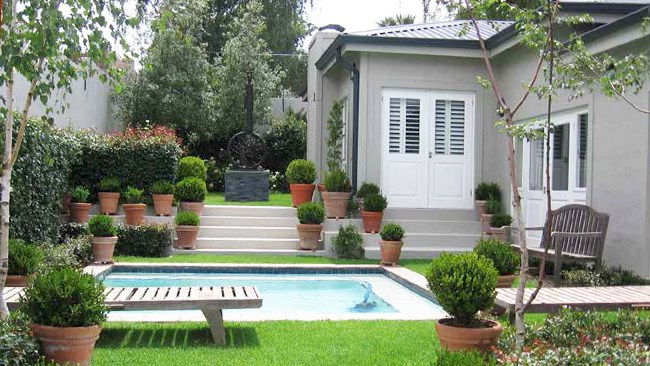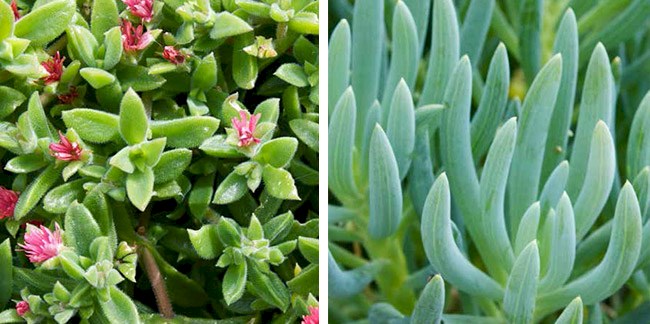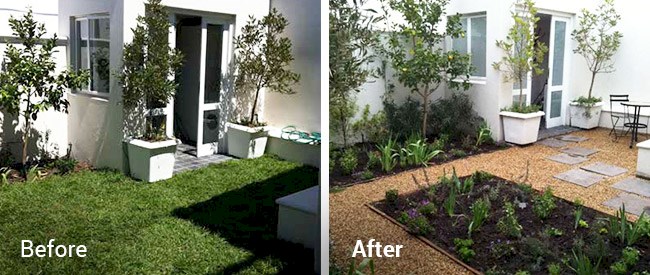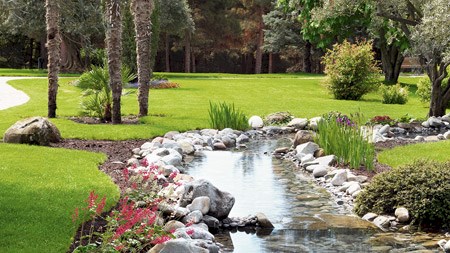Potential buyers look at more than just the house in front of them – the garden completes the package, and often sways their decision.
One of the most critical decisions to be made concerns structure and focus. This clearly defined entertaining area is cleverly planted with scented greenery that also creates additional protection from the wind. The water feature not only draws the eye to a different level, but provides a soothing background of sound in the garden. It’s also a fairly low- maintenance garden that doesn’t require lots of water.
Potential buyers look at more than just the house in front of them – the garden completes the package, and often sways their decision. So, are you planning to move but don’t have the vision, never mind green fingers? Then bring in an experienced garden designer or landscaper to create a garden that buyers will fall in love with… but plan ahead so that you can enjoy it too!

“A well-maintained and cared for garden not only attracts buyers but also tends to evoke confidence in the manner in which the owner has taken care of the whole property, including the dwelling," says Regan Harris, MD of Hamilton’s Property Portfolio. But it’s not just maintenance that’s important – it’s what gives one garden the edge over another. "A landscaped garden gives a buyer a chance to be impressed and to link the house and garden in one package deal. It is difficult to put a cost or value on a well-maintained or landscaped garden but, without doubt, it makes a substantial difference to the saleability of your property. When buyers are confronted by an untidy garden and they see a lot of work, they deduct the cost that they will have to outlay to upgrade the garden from the asking price," agrees Myles Wakefield, CEO of Wakefields Real Estate.
"A R5million home without a landscaped garden, or at least an appealing garden, will definitely have less value to a potential buyer. People want to move into the 'prettiness' rather than work on it," says Dietlyn Bekker of Soukop Properties Durban north. "On the other hand, buyers of a R1million home usually like to potter around the garden themselves, so a neat garden as opposed to a landscaped garden is more important in their purchasing criteria." There is no doubt that a well-maintained, tidy garden makes a property more appealing to potential buyers.
"The garden provides a beautiful setting for the home. a weed-free, neat and clean garden, with dead plants and trees cut back to let the light into the garden, and plantings of some colourful annuals makes a big difference and is not expensive," says Wakefield. "It is possible to enhance your garden yourself without huge cost, starting with free advice from your local nursery about suitable plants and their placing in your garden."
Johannesburg landscaper and designer of The Kentridge Gardens, Jane Henderson, says that a garden adds value to a home in both monetary and more intangible terms. "Prospective buyers are definitely influenced by the state of the garden as a lot of people simply do not have the foresight or knowledge to visualise a pretty garden if they are faced with an overgrown jungle. A beautiful garden comes at a price and indicates that the owners have spent a considerable amount to maintain it. It therefore must add value in monetary terms. In a less tangible way – a garden is an extension of the home and as the pace of living increases more people are recognising the value of being able to relax in the relative peace and tranquillity of their home gardens."
Current trends

‘Going green’ is the trend in gardening as in many other areas of design. In the case of gardens, going green means the transition to indigenous plants and trees that are water-wise.
"The green theme that has swept through architecture is leading garden design, too," says Juanita Knox of JK Design, www.jkdesign. co.za, who works in Cape Town, the Garden route and Johannesburg. Recycling and low-maintenance, indigenous planting is key. "Indigenous plants differ from region to region, and a quick guide would be to visit the botanical garden in your area and enjoy looking at what thrives, and its long-term growth capacity," advises Juanita. "To avoid overplanting your stand, pick a theme, based on your architecture and climate, and develop a plant plan."
Simon Clements, www.simonclements.co.za, a Durban-based garden and landscape designer, says the trend is for "designs that mimic our natural surrounds - veld, forest and glade - creating urban indigenous wildernesses that allow people to feel lost in a small urban space." ‘Indigenous gardening just makes sense. Indigenous species are adapted to our South African soils and our specific climatic conditions. It therefore follows that they do better, produce healthier seed, utilise less water to thrive, and attract local birds and pollinators to our gardens,’ says Heidi Bertish, a garden designer and published garden photographer based in Cape Town.
Chris Maddams of Red Daffodil, www.reddaffodil.co.za, which has branches in Cape Town and Johannesburg, says that being water-wise, having an understanding and sympathy for your local environment in planting indigenous, and aiming for organic principles in pest care and feeding have been established for a while. "Principles that are accelerating are definitely anti-lawn – seeing as they take the greatest amount of water and upkeep – and filling in or moving swimming pools. Plant-wise, grasses are noticeable in their popularity. because they need to be planted en masse, they suit both modern and traditional styles, plus we are seeing new varieties of both indigenous and exotic grasses that are suitable for smaller gardens."
Hot Tip: "My best advice if you want to go indigenous is to take a look at the trees you have," says Chris. "Most of the mature trees I see in urban gardens are exotics, so why not go out and buy an indigenous tree, plant it as close as possible (or choose something that is used to growing under a canopy like a Forest Alder or Nuxia floribunda) and over time trim back the exotic until the new tree can replace it without you ever having to lose your privacy or shade - in effect creating a succession plan." Jane says, "Frankly I am not really influenced by trends and feel that it is of prime importance that the garden and house are in harmony. Each garden has its own unique character as does its owner. as with any art form, it is subjective and individual. The house, trees, shrubs and lawns must form part of an integrated whole. However, in the light of the availability of water in South Africa, I would say that the general trend is towards water-wise gardening and indigenous plantings."

How to make the change to indigenous gardens: Tips from Simon Clements
- Spend time at your nursery and look for plants that are locally indigenous. There are some fantastic sites, such as www.plantzafrica.com, that will give you detailed information on a wide variety of indigenous and locally-indigenous plants.
- Spend time getting to know which parts of your garden are in sun and shade at what times in the day and what times in the year – this will help you buy and place plants in areas they will thrive in. iPhone apps such as Helios are very useful in forming a ‘sun-map’.
- Break your garden up into ‘zones’ and deal with each zone separately over time: this makes the transformation less daunting and more achievable.
- Identify key plants and trees that you want throughout the garden: this ensures that there is a common thread and gives the garden more ‘flow’.
- Look at how things grow naturally in nature reserves and other wild areas and mimic this look. This often means buying and planting in bulk. Indigenous plants can also be very successfully used in formal garden designs.
- Ensure that fresh, clean drinking water for insects, birds and other wildlife is available. Remember that butterflies and other insects need very shallow water/wet sand to drink from.
Smart water solutions
Indigenous gardens are naturally water-wise and one of the best ways to cut down on your water consumption. If your garden is not completely indigenous, though, there are other ways to reduce your water usage. "People are definitely more water-wise and like to see irrigation systems as well as gutters that save rainwater to underground water tanks (some people fill in old pools with this green water when building a new pool) or JoJo slim-line water tanks connected to the gutters. Some people use their grey water to irrigate their gardens," says Bekker of buyers’ thoughts on water use in gardens.
The experts' tips for being water-wise:
- "Garden with plants that will thrive in your specific soil and site conditions." Heidi Bertish
- "Watering long and deep less often rather than shallow watering more frequently will encourage deep rooting plants that are healthier and more tolerant of dry spells." Heidi Bertish
- "Prep the soil as well as possible with organic compost or river sand when in clay and fertilise with bounce back twice a year." Juanita Knox
- "Get the ground cover to spread as quickly as possible. maybe plant a few more of these so that evaporation is down to a minimum, and mulch with bark or recycled branch chips which also slows evaporation." Juanita Knox
- "Pick plants with similar water needs and group these together. Shade plants should be together, like clivia species with plectranthus varieties, and in hot sunny areas, aloes with other succulent species, like lampranthus (vygies) and cotyledon varieties." Juanita Knox

CHOOSE A THEME
Edible gardens
"Fuelled by increased petrol costs, worldwide food hikes and a growing environmental awareness, “grow your own” is a big thing," says Heidi Bertish. "I believe this movement will only gather momentum as we choose to tread more gently on the earth, look for alternatives to genetically modified food and prefer foods grown in healthy soils free from a multitude of sprays." "While herb gardens have always been popular, growing your own veggies is really taking off," says Chris Maddams. "This is partly due to people realising how easy some of it is and partly because of people wanting to know and understand the provenance of their food. In young families it’s really a big thing for kids - it involves them in the garden and educates them."
Beach gardens
"A beach garden is a completely eco-friendly way of conserving the natural landscape and is a paradigm shift in historic thinking – that this landscape should be converted to an english cottage garden,’' says Juanita Knox. Creating a beach garden from scratch requires a complete overhaul says Juanita. "You would need to take out all of the wrong plants and features, develop sand dunes and try to link in with the natural dune system in the area. This garden is only suited to the properties on the front line of beach homes as further back, the natural flora would develop into coastal fynbos and then coastal thicket in the Western Cape. In KwaZulu-natal the styles are a little different as you move away from the dunes, but fairly similar at beach and dune stage.’ Despite the hard work that may be required to establish a beach garden, once it is thriving, it requires very little maintenance. "An initial three weeks watering is required and then the garden should only be weeded monthly after that, and cut back once a year. The wind, salt spray and natural weather should do all the rest."
IMPROVING YOUR GARDEN
How to prepare your garden for show day - tips from Laurian Brown, Sunday Times Garden editor
If you are planning on selling your house, it is important that you get your garden looking its best.
- It is imperative to tidy up your garden before potential buyers come knocking. make sure that tumble-down and makeshift structures are removed and thin out foliage and shrubs. It is a good idea to get a professional garden service or tree feller to do this as you still want the garden to look full, just not overgrown.
- Spend an afternoon weeding and removing sickly-looking plants.
- Spread a lot of good mulch, such as bark or peanut shells, which helps to make a garden look tidy.
- Place a bench under a tree or a wrought-iron table and chairs on the lawn to make the garden looked lived in and used. buyers are looking for a garden that they can enjoy.
- Many people need to look at properties in the evening after work so invest in some solar-powered lights to attractively illuminate areas of the garden.
- Think about using potted plants to enhance outdoor spaces. Group pots of different sizes, shapes and colours together on a patio or place a potted tree on either side of your front door.
- The main impression you need to give potential buyers is that your outdoor spaces and gardens have been well cared for and are places where they will want to spend time.
How to make your garden look cared for, in a weekend
If you are not planning a move just yet, but feel inspired to get your garden in tip-top shape, these are Heidi Bertish’s tips:
- Neaten and redefine the shape and edges of your beds and paths to instantly add pizzazz to your space.
- Mow, feed and water your lawn for a luxurious green carpet all summer.
- Cut back and thin out plants that over crowd each other at the expense of the original design.
- By grouping like species together in generous swathes a more sophisticated look will be created.
- Deadhead flowering perennials (and at the same time collect seed from those you’d fancy re-sowing in another area next season).
- Group your pots according to shape, ensure your plant colours work together and that planting looks generous and healthy.
- Splitting and dividing bulbs, and pinching out the terminal shoot of your roses will ensure that both retain their vigour and flower in abundance.




